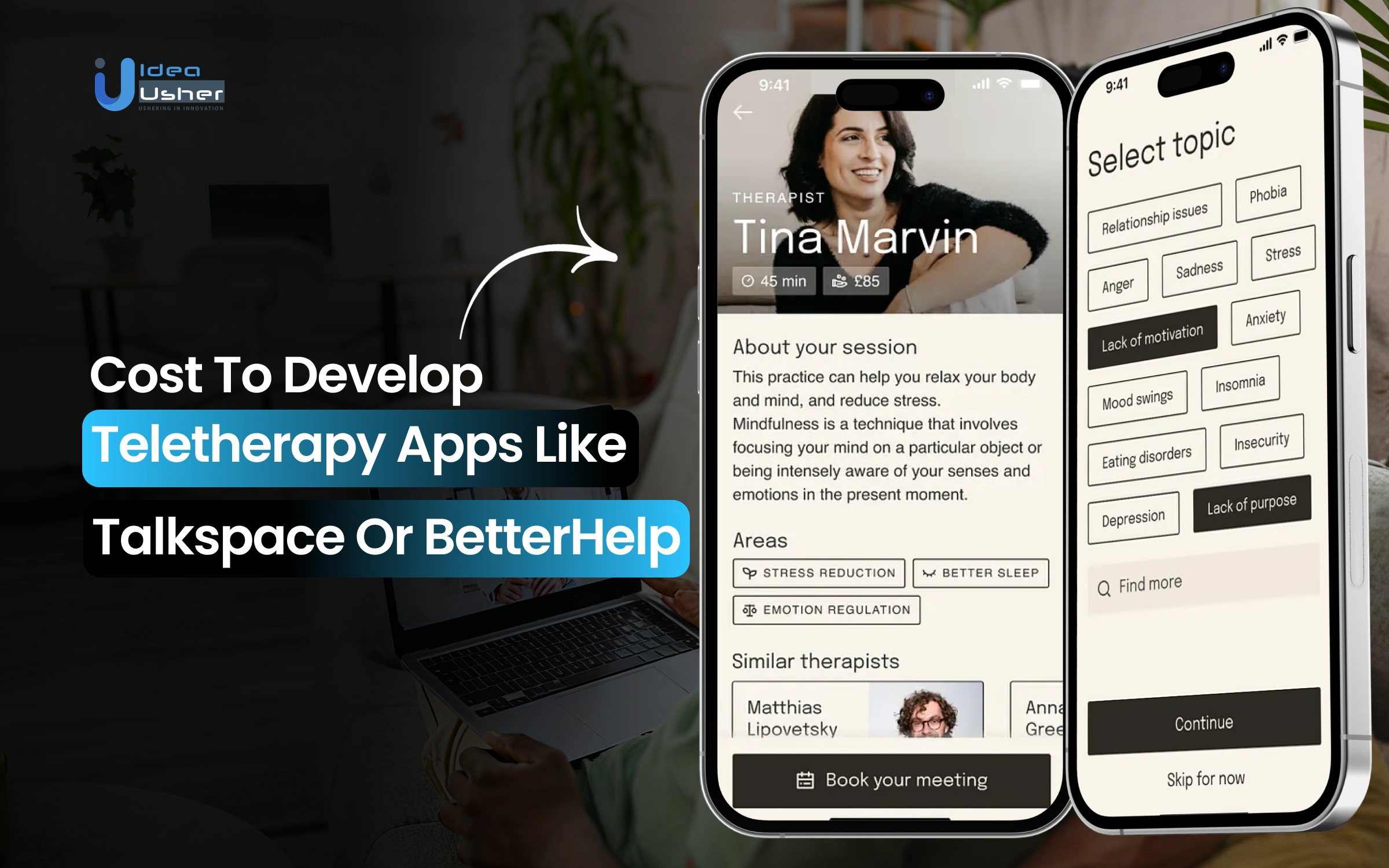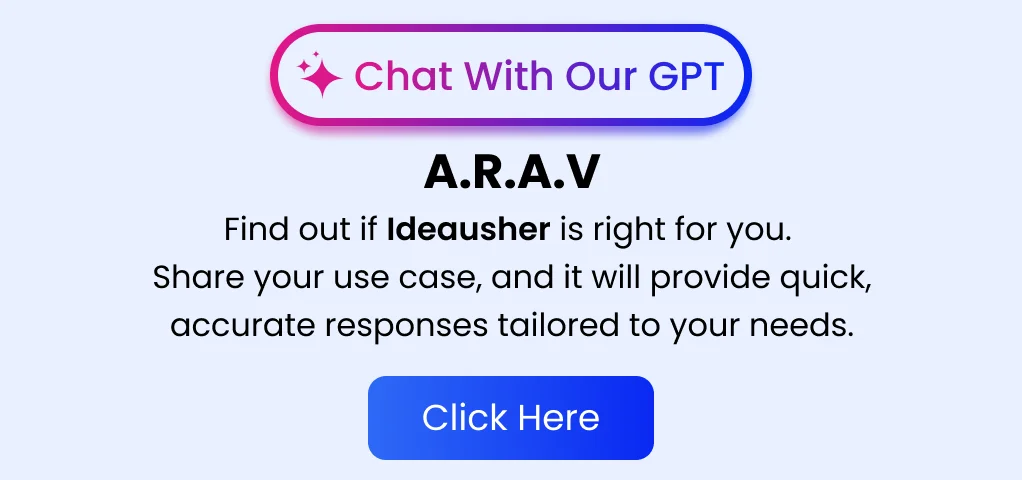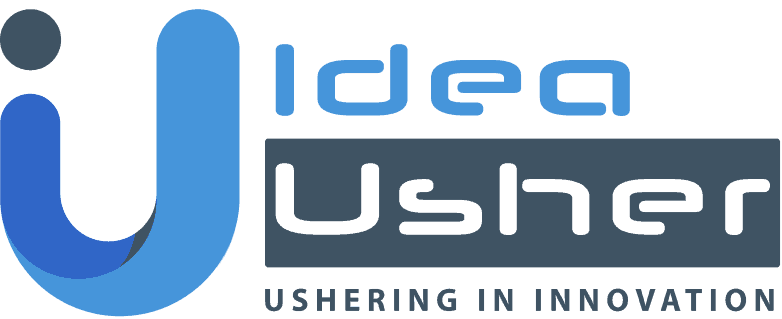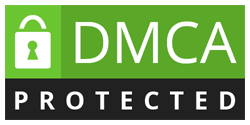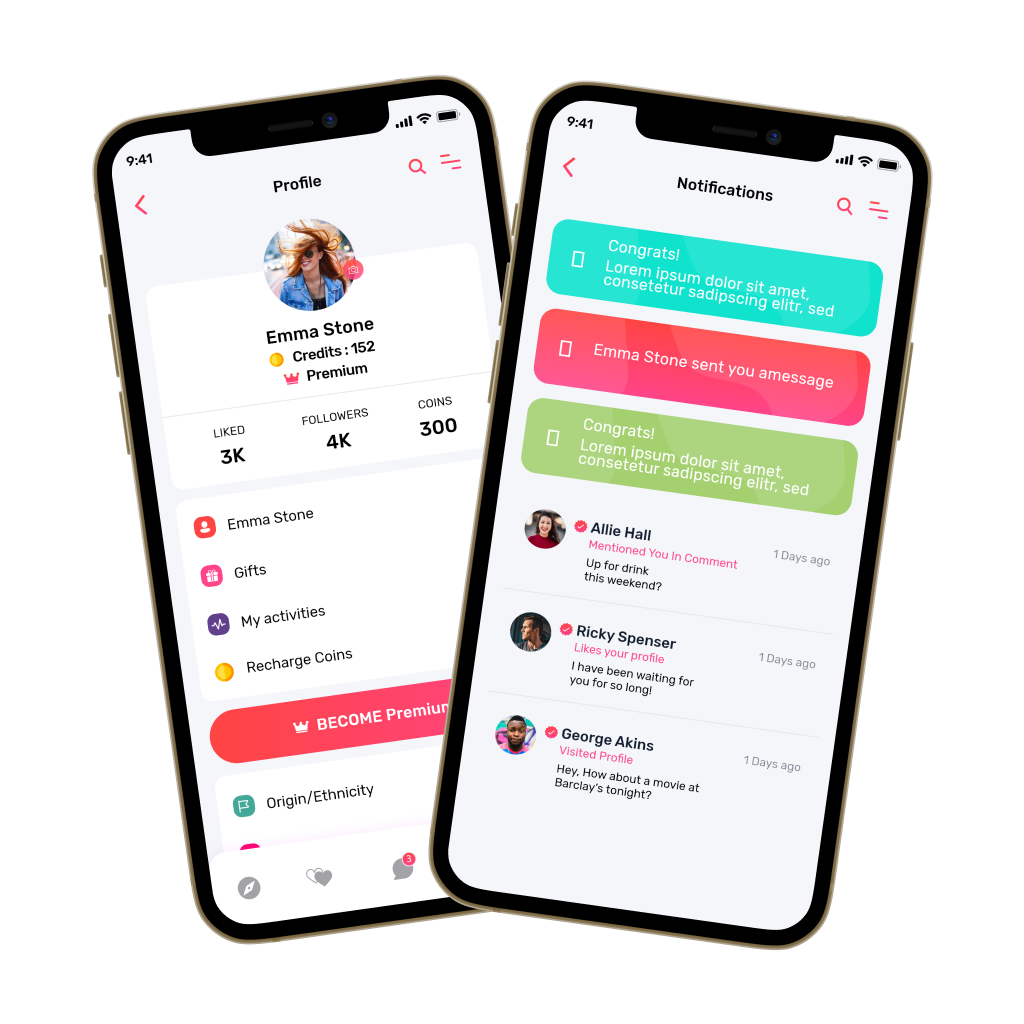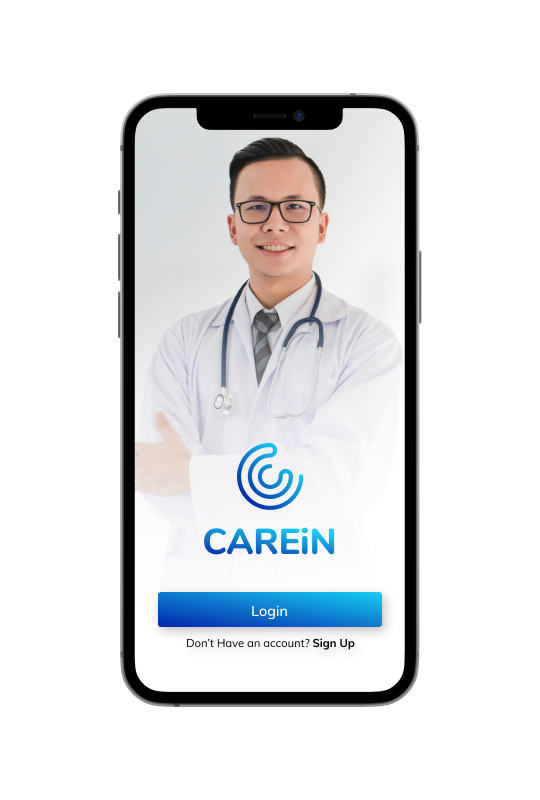Teletherapy has really changed the way we think about mental healthcare. Platforms like Talkspace and BetterHelp allow people to connect with professionals remotely and at their convenience. The ability to schedule sessions easily and communicate through secure video calls or messages makes therapy more accessible than ever. With the growing need for flexible mental health options, businesses have a unique chance to create services that reach millions. By stepping into this space, companies can not only increase revenue but also help make a difference in people’s lives.
We have worked with several health-tech founders and seen how teletherapy apps can bring real therapy closer to people. With that experience, we at IdeaUsher have helped numerous healthcare businesses and entrepreneurs build telehealth apps that feel safe and personal while remaining secure.
We’re writing this blog to break down the costs involved in developing teletherapy apps like Talkspace or BetterHelp. This will help you make informed decisions as you begin your journey.
Key Market Takeaways for Teletherapy Apps
According to GrandViewResearch, the global mental health app market was valued at USD 7.48 billion in 2024 and is expected to reach USD 17.52 billion by 2030, growing at a steady 14.6% CAGR. This rise highlights how teletherapy apps are becoming essential in making mental health care more accessible, flexible, and user-friendly.

Source: GrandViewResearch
Teletherapy platforms are redefining convenience and connection. Apps like BetterHelp, Talkspace, and PlushCare let users speak with licensed therapists through video, voice, or chat, all from the comfort of home. With smart features like instant therapist matching and AI-based mood tracking, therapy is now more personal and easier to fit into daily life.
Partnerships are driving the next phase of growth. Companies such as Teladoc Health and Amwell are bringing teletherapy to workplaces and schools, helping improve well-being and productivity. Together, these collaborations are building a future where mental health support is available to anyone, anytime.
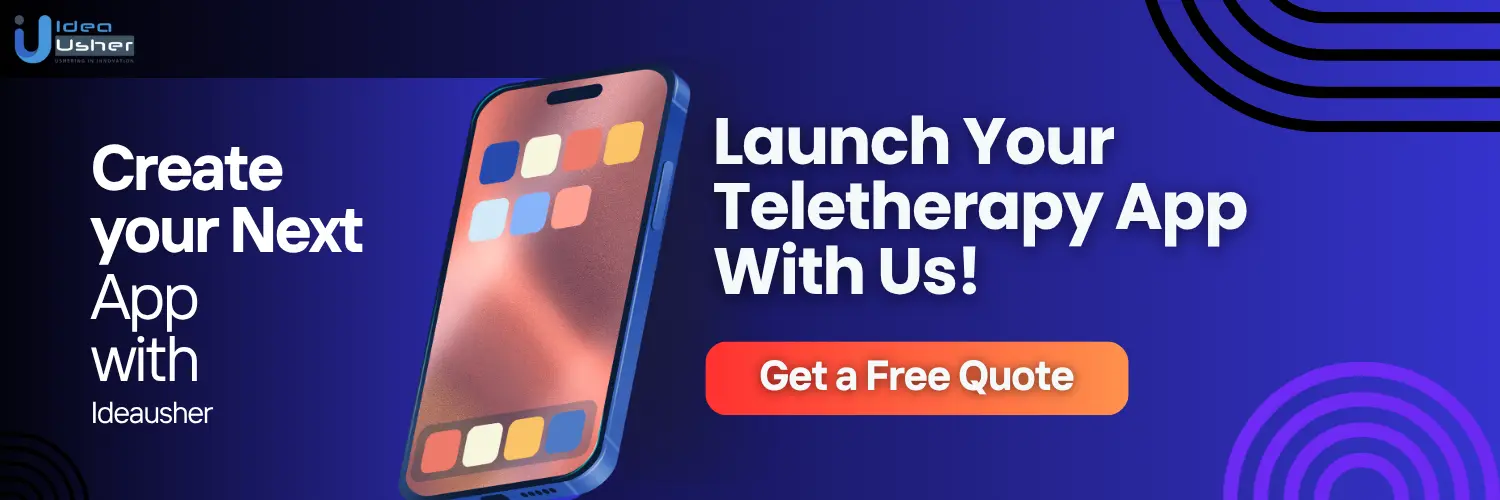
What Are Teletherapy Apps?
Teletherapy apps are digital tools that let people talk to licensed therapists through video calls, text, or voice notes. They aim to make therapy easier to access and more affordable for anyone who might need it. Users can reach help without worrying about travel or fixed schedules. These apps often include features like mood tracking and journaling to support consistent progress. They may also manage prescriptions, turning a phone into a full mental health system.
Core Functions
A strong teletherapy app does more than run video sessions. It builds a safe and consistent space for mental health care that fits easily into daily life.
- Secure Messaging: Acts like a private therapy journal where users can send text, voice, or short video notes between sessions. Therapists reply within a set time to maintain steady communication.
- Live Video Calls: The main feature that mirrors in-person therapy. Clear, low-latency video helps preserve facial cues and emotional connection.
- Voice Notes: Offers a personal and expressive way to share thoughts. Users can capture tone and feeling better than through text alone.
- Mood Tracking & Journaling: Lets users log emotions, triggers, and reflections each day. This data helps both user and therapist spot patterns and track growth over time.
- Prescription Management: Some platforms include licensed psychiatric care. Providers can assess, prescribe, and manage medication directly within the app, creating a smooth, single-system experience.
Three Main Types of Teletherapy Apps
Teletherapy has evolved far beyond a single model. Today’s platforms cater to various needs, helping create a more inclusive mental health space.
1. The Individual Therapy Platform
This model mainly connects users with licensed therapists for one-on-one talk therapy. It focuses on quick access so people can often start sessions within a few hours. After a short questionnaire the system automatically matches each user with a therapist and opens channels for chat calls or video sessions.
Business Model: Simple subscriptions, billed weekly or monthly.
Examples:
- BetterHelp: The largest and most well-known platform, offering flexible communication formats and an extensive therapist network.
- Calmerry: A cost-effective alternative that focuses on text and video therapy with a streamlined experience.
2. The Integrated Therapy & Psychiatry Platform
This model combines therapy with medical care to treat both emotional and biological aspects of mental health. It focuses on complete support where users might talk to a therapist and also manage medication in the same space. The platform links both services under one account so care can flow smoothly between providers.
Business Model: Separate plans for therapy and psychiatry, often integrated with health insurance to reduce costs.
Examples:
- Talkspace: Pioneers integrated mental health care with direct insurance coverage and shared treatment plans between therapists and prescribers.
- Brightside: Focuses on anxiety and depression treatment, combining therapy with personalized medication plans.
- Cerebral: Offers ongoing medication management, therapy, and self-paced lessons in a structured program.
3. The Specialized Therapy App
These platforms are built for specific groups or therapy needs and aim to deliver culturally aware care. They focus on expertise that truly connects with each community and builds real comfort. Every part of the system, from therapist matching to interface design, is shaped for that audience to keep sessions relevant and supportive.
Business Model: Can be subscription-based or sometimes offered through employer or organization partnerships.
Examples:
- TeenCounseling: Built for adolescents, combining licensed therapists with parental consent workflows.
- Regain: Focused on couples therapy, offering shared and private channels for both partners and their therapist.
- Ayana Therapy: Matches clients with therapists who share their cultural background, identity, or lived experiences.
How Apps like Talkspace and BetterHelp Make Money?
Teletherapy apps typically earn through direct subscriptions, where users pay for weekly or monthly access to therapy. They also partner with companies and insurance providers to offer services as part of employee benefits or insurance coverage. Some platforms even offer pay-per-service options, letting users pay for individual sessions when they need specific help without committing long-term.
Teletherapy platforms typically rely on three core revenue channels,
1. B2C Subscriptions
This model is simple and popular with users who pay for direct access to therapy. Typically, users subscribe on a weekly or monthly basis and get unlimited messaging along with a set number of live sessions. It’s a straightforward way for platforms to earn regular income.
Examples & Pricing:
- BetterHelp: Charges users between $70 – $100 per week (billed monthly), with variations based on location, therapist availability, and demand.
- Talkspace: Offers therapy plans starting at $69 per week. Psychiatry plans, which include medication management, are priced separately, often starting at $199 for the initial evaluation and $125 for follow-up sessions.
The Strategy: This model provides a predictable, recurring revenue stream (MRR), helping platforms to establish direct consumer relationships and financial stability.
2. B2B2C Partnerships
This model is highly scalable because teletherapy apps work with large companies and insurance providers. They become in-network for insurers, who then cover most costs, with users paying a small copay. Employers also offer these services as part of benefits packages, paying a fixed fee per employee.
Examples & Impact:
- Talkspace: Has secured partnerships with over 100 million covered lives through insurance companies like Optum, Cigna, and Aetna, as well as employers such as Google and Meta.
- BetterHelp’s parent company, Teladoc, uses its enterprise connections to cross-sell mental health services to existing corporate clients.
3. Pay-Per-Service & A La Carte Models
This model is for users who want specific services without committing to regular therapy. They pay for individual sessions or consultations like psychiatric evaluations. It’s a flexible option for those needing help without long-term commitments.
Example:
- Talkspace offers standalone psychiatry services. A user can book a one-off medication management appointment without the need for a subscription to weekly therapy.
Revenue Potential of Apps Like Talkspace and BetterHelp
The digital mental health market is booming, and platforms like Talkspace and BetterHelp are leading the charge. These apps have proven that with the right business model and growth strategy, they can generate billions annually.
While scaling may vary, the revenue potential for teletherapy services is immense. If executed well, these platforms could become massive financial powerhouses.
1. Financial Performance of BetterHelp
BetterHelp, a subsidiary of Teladoc Health, is the undisputed leader in the direct-to-consumer teletherapy space. While Teladoc doesn’t report exact figures for BetterHelp, analysts have provided an estimated financial picture.
Estimated Annual Revenue: BetterHelp’s annual revenue is estimated to exceed $1 billion. In fact, Teladoc’s “Integrated Care” segment, which is primarily powered by BetterHelp, reported $1.14 billion in 2023.
The Engine of Growth:
- Massive User Base: BetterHelp’s model thrives on volume, with an estimated 2 million+ paying users and a network of over 32,000 therapists.
- Pricing Power: Charging users between $70 to $100 per week (billed monthly), the platform’s average revenue per user is substantial.
- Aggressive Marketing: The platform’s massive scale is supported by an extensive marketing budget. In 2022, Teladoc spent $454 million marketing its direct-to-consumer segment, proving the high costs, but even higher payoffs, of dominating the B2C market.
2. Financial Performance of Talkspace
Talkspace, a publicly traded company, offers a different financial story with a focus on business-to-business (B2B) partnerships, such as insurance and employer collaborations.
Actual Annual Revenue: Talkspace reported $150.1 million in total revenue for 2023, showing a solid 17% increase year-over-year.
The Engine of Growth:
- B2B Dominance: 85% of its Q4 2023 revenue came from its B2B channels (insurance and employers). This model gives Talkspace access to over 100 million covered lives through partnerships with major companies like Aetna, Cigna, and Optum.
- Revenue Structure: Talkspace’s revenue comes from a combination of per-member fees from employers and session reimbursements from insurers, resulting in a more predictable, recurring revenue stream.
- Path to Profitability: After a period of restructuring, Talkspace achieved its first quarter of positive Adjusted EBITDA in Q4 2023, demonstrating the financial viability of its B2B/insurance model at scale.
Breaking Down the Revenue Potential for New Entrants
A new teletherapy app can expect different revenue potential depending on its growth stage and business model. Early on, focusing on user acquisition could help build a solid customer base. As it grows, the revenue could rise steadily through subscriptions, partnerships, and premium features.
Early-Stage / MVP (Year 1-2):
- Focus: Building product-market fit and acquiring initial users.
- Potential Revenue: A niche app with 100-500 active users paying around $65 per week could generate anywhere from $338,000 to $1.69 million in Annual Recurring Revenue or ARR.
- Note: At this stage, marketing expenses typically outpace revenue as the app establishes its user base.
Growth-Stage / Market Contender (Year 3-5):
- Focus: Expanding the user base and adding more service offerings.
- Potential Revenue: With 5,000 to 20,000 active users, revenue could range between $16.9 million and $67.6 million in ARR.
- Key Move: Introducing a B2B arm or integrating with insurance at this stage can drastically accelerate growth, as evidenced by Talkspace’s success.
Established Leader / Scaled Platform (Year 5+):
- Focus: Market dominance and diversification of revenue sources.
- Potential Revenue: Here, the ceiling is defined by industry giants like BetterHelp. The B2C model has the potential to scale to more than $1 billion in ARR. On the B2B side, Talkspace’s access to over 100 million lives suggests a path to hundreds of millions of dollars in revenue.

Cost to Develop Teletherapy Apps Like Talkspace or BetterHelp
Building a teletherapy app like Talkspace or BetterHelp is quite a serious project that sits firmly in the HealthTech space. You will need to think beyond just good design because the app must follow strict data protection rules like HIPAA and GDPR. The overall cost and timeline will mostly depend on how complex you want the platform to be and what features you decide to include.
Cost breakdown: Talkspace-style app
Here are features suited for Talkspace-type, with cost estimates.
| Feature | What must be included (Talkspace style) | Cost (MVP) | Cost (Full/Production) |
| Onboarding + Profiles | Clients & therapists; therapist credential verification; possibly psychiatrist licensure; more detailed profile (specialties, insurance accepted, location, etc.) | $5,000 – $10,000 | $15,000 – $30,000 |
| Matching / Intake Flow | Depth of questionnaires (mental health, severity, risk), triage, maybe severity screening; matching rules with therapist specialties/licensure | $5,000 – $12,000 | $15,000 – $50,000 |
| Messaging (text + attachments) | Secure, asynchronous messaging; attachments; maybe file uploads; policy for response times; logging; maybe integration with moderated content | $8,000 – $20,000 | $25,000 – $60,000 |
| Live Video / Audio Sessions | High quality, perhaps group sessions, video history/recording (if required), maybe multi-party, switching between video/audio modes | $10,000 – $25,000 | $30,000 – $80,000 |
| Scheduling & Calendar Sync | Complex calendar availability across therapists; patient scheduling; reminders; time-zones; cancellations; syncing with Google/Apple etc. | $5,000 – $12,000 | $12,000 – $30,000 |
| Payments, Subscription, Insurance / Billing | Accept payments, multiple subscription tiers; integrate insurance or employer payments; invoicing; refunds; maybe claims processing | $5,000 – $12,000 | $15,000 – $40,000 |
| Therapist Admin Portal / Dashboard | Approvals, scheduling view; caseload; billing; client matching; notes; maybe clinical supervision features; reporting | $8,000 – $18,000 | $20,000 – $50,000 |
| Clinical Notes & Secure Storage | Encrypted storage; audit trails; exporting; long-term retention; multi-user access control; possibly psychiatric note types | $5,000 – $12,000 | $15,000 – $40,000 |
| Push Notifications & Reminders | Session reminders; overdue responses; alerts to therapists; notification compliance | $1,500 – $4,000 | $4,000 – $10,000 |
| Ratings, Feedback, Reviews | Post-session feedback; quality indicators; possibly peer reviews; moderation | $2,500 – $5,000 | $6,000 – $15,000 |
| Content / Self-Help Library | More robust: licensed media; articles; video courses; perhaps workshops; interactive tools | $3,000 – $8,000 | $10,000 – $30,000 |
| Assessments & Trackers | Mental health assessments; possibly risk screens; depression/anxiety scales; alerting if crisis; ongoing tracking dashboards | $4,000 – $10,000 | $12,000 – $30,000 |
| Security & Compliance (HIPAA, etc.) | Very strong: legal reviews, business associate agreements, privacy policy, data encryption, risk assessments, perhaps disaster recovery | $10,000 – $30,000 | $50,000 – $150,000+ |
| Infrastructure & Scalability | High availability; scalable video; server redundancy; logging; scaling for many concurrent sessions | $5,000 – $15,000 | $20,000 – $70,000+ |
| Analytics, Search & Reporting | Client outcomes analytics; therapist metrics; usage reporting; dashboards for enterprise clients | $5,000 – $12,000 | $15,000 – $40,000 |
| Admin / CMS / Support Tools | Full user-management; disputes; content lifts; therapist credentialing workflows; audit logs; support ticketing systems | $6,000 – $15,000 | $20,000 – $60,000 |
| QA, Testing & Deployment | Manual + automated tests; compliance audit; security testing; continuous integration/delivery | $6,000 – $15,000 | $15,000 – $50,000 |
| Legal / Regulatory / Third-party Fees | Costs for lawyers; HIPAA documentation; licensure verification; BAA with any service providers; payments processing fees | $3,000 – $10,000 | $10,000 – $40,000+ |
Total cost estimates: Talkspace-style
- MVP (lean Talkspace-like version): ≈ $150,000 – $300,000
- Full production, high scale, enterprise-ready: ≈ $400,000 – $800,000+
For a Talkspace-style app, the total development cost is estimated to range from $150,000 to $800,000+ USD. This estimate depends on the features and complexity you require for your platform.
Cost breakdown: BetterHelp-style app
This tends to be somewhat simpler, fewer regulatory extremes (if no prescribing), more focus on volume + counselor supply, usability, UX, matching, less on clinical psychiatry workflows.
| Feature | What must be included (BetterHelp style) | Cost (MVP) | Cost (Full/Production) |
| Onboarding + Profiles | Client & therapist profiles; therapist credentials but simpler; specialties; availability; less complex verification | $4,000 – $8,000 | $12,000 – $25,000 |
| Matching / Intake Flow | Preference-based matching; basic questionnaires (e.g. preferences, maybe severity) | $4,000 – $10,000 | $10,000 – $30,000 |
| Messaging (text + attachments) | Secure messaging; maybe attachments; read receipts; less rigorous audit for prescribing | $7,000 – $15,000 | $20,000 – $50,000 |
| Live Video / Audio Sessions | Scheduled video; maybe audio only; recording optional or limited; simpler UI | $8,000 – $20,000 | $25,000 – $60,000 |
| Scheduling & Calendar Sync | Therapist availability; client booking; notifications for sessions | $4,000 – $10,000 | $10,000 – $25,000 |
| Payments & Subscriptions | Subscription payment, tiered counseling packages; refunds; promo codes; maybe partner or corporate discounts | $4,000 – $10,000 | $12,000 – $35,000 |
| Therapist Admin Portal / Dashboard | Basic tools: accept clients, calendar, messaging view, notes | $6,000 – $12,000 | $15,000 – $40,000 |
| Clinical Notes & Secure Storage | Probably simpler than psychiatric settings; but still encrypted, access control | $4,000 – $10,000 | $10,000 – $30,000 |
| Push Notifications & Reminders** | Reminders for upcoming sessions; follow-ups; messaging alerts | $1,500 – $3,500 | $4,000 – $8,000 |
| Ratings, Reviews, Feedback | Feedback after sessions; reviews of therapist; possibly searching by rating | $2,000 – $4,500 | $5,000 – $12,000 |
| Content / Self-Help Library | Articles, videos, worksheets, maybe moderated content | $2,500 – $7,500 | $8,000 – $25,000 |
| Assessments & Trackers | Mood tracking, symptom checkers, progress tracking; perhaps no crisis workflow or less complex | $3,500 – $8,000 | $10,000 – $25,000 |
| Security & Compliance | Strong privacy, encryption; possibly HIPAA if US-based; but less overhead than prescribing | $8,000 – $20,000 | $30,000 – $100,000+ |
| Infrastructure & Scalability | Moderate scaling; fewer peak load/enterprise clients | $4,000 – $12,000 | $15,000 – $50,000+ |
| Analytics & Reporting | User metrics; retention; matching effectiveness; therapist performance | $4,000 – $10,000 | $10,000 – $30,000 |
| Admin / CMS / Support Tools | Basic content management; user support; therapist onboarding; scheduling conflicts | $5,000 – $12,000 | $15,000 – $40,000 |
| QA, Testing & Deployments | Necessary testing; simpler regulatory audit; deployment pipelines | $5,000 – $12,000 | $12,000 – $40,000 |
| Legal / Regulatory / Third-party Fees | Terms/privacy; possibly HIPAA; payment processor fees; licensure costs for therapist verification | $2,500 – $8,000 | $8,000 – $30,000 |
Total cost estimates: BetterHelp-style
- MVP (lean BetterHelp-like): ≈ $100,000 – $200,000
- Full production, scaling, polish: ≈ $250,000 – $500,000+
For a BetterHelp-style app, the estimated development cost ranges from $100,000 to $500,000+ USD. For a more precise quote, feel free to reach out for a free consultation.

Cost to Have AI Features in Apps like Talkspace and BetterHelp
The cost of adding AI features to telehealth platforms like Talkspace and BetterHelp varies depending on the complexity and number of services included.
While AI can enhance care and accessibility, it’s an ongoing investment with both initial and maintenance costs. It’s important for leaders to understand that these expenses can differ, but they are essential to keep up with evolving needs. Ultimately, AI brings value, but it requires a long-term commitment to be effective.
Cost of Integrating AI in a Talkspace-Like Platform
Platform Type: Asynchronous, Text-Based Therapy Platform
Talkspace operates primarily through text, audio, and video messaging with a dedicated therapist, rather than focusing solely on live sessions. It is a subscription-based “therapy in your pocket” model that provides flexible mental health support.
Why AI Integration Can Be Beneficial?
Managing large amounts of unstructured text in an asynchronous model can be tough. AI can really help by automating tasks and supporting therapists, easing their workload. This makes it easier to provide constant and accessible support to clients while preventing burnout.
Key AI Features & Their Cost Factors
| Feature | Description | Cost Factors |
| AI-Powered Intake & Matching Assistant | An AI chatbot that conducts intake, assesses needs, and suggests the best therapist. | Development: Custom NLP for clinical assessments. $40,000 – $70,000Data & Training: Fine-tuning AI on therapeutic modalities. $15,000 – $30,000 |
| Therapeutic Conversational Support | AI-powered chatbot offering CBT-based exercises and mood tracking between sessions. | Development: Building a rule-guided AI. $80,000 – $150,000+Clinical Oversight: Ongoing professional review. $5,000 – $15,000/month |
| Provider Tool: AI Session Note Generator | AI that auto-generates SOAP or BIRP notes from therapist-client message threads. | Development: Secure data processing for HIPAA compliance. $50,000 – $90,000 |
| AI-Powered Mood & Progress Tracker | A tool that tracks client moods and therapeutic progress using AI-driven analytics. | Development: Building predictive models for mood tracking. $30,000 – $60,000Data & Training: Analyzing behavioral patterns. $10,000 – $20,000 |
| Automated Client Feedback Analyzer | AI that analyzes client feedback to identify trends and insights for improving therapy. | Development: NLP-based sentiment analysis. $25,000 – $50,000Data & Training: AI refinement for accurate feedback analysis. $8,000 – $15,000 |
| AI-Driven Appointment Scheduling | AI-based system for managing appointments, sending reminders, and optimizing therapist availability. | Development: Integrating AI into calendar systems. $20,000 – $40,000Maintenance: Regular system updates. $2,000 – $5,000/month |
Estimated Total Investment for a Talkspace-like AI Suite
- Initial Development: $180,000 – $330,000+
- Annual Ongoing Costs: $90,000 – $336,000+
Cost of Integrating AI in a BetterHelp-Like Platform
Platform Type: Mixed-Modality Therapy Platform with a Live Session Emphasis
BetterHelp offers live video, phone, and chat sessions, along with journaling and group workshops. It is built around providing a broad range of tools to meet the needs of a larger audience, with a focus on live sessions.
Why AI Integration Can Be Beneficial?
BetterHelp’s AI integration is designed to augment the live session experience, provide therapists with advanced insights during sessions, and manage a large and diverse user base. AI helps create a more personalized and scalable therapeutic experience, making the platform more effective and engaging.
Key AI Features & Their Cost Factors
| Feature | Description | Cost Factors |
| Real-Time Session Co-Pilot for Therapists | AI transcribes live sessions and provides real-time insights to therapists. | Development: Real-time audio processing and low-latency analysis. $120,000 – $250,000+API Costs: Real-time audio-to-text and AI analysis. $4,000 – $15,000/month |
| AI-Powered Progress Tracker & Insights Dashboard | AI-powered dashboard that tracks and visualizes client progress from multiple data sources. | Development: Building a data pipeline and visualization system. $60,000 – $100,000 |
| Advanced Content Personalization Engine | AI engine that recommends personalized content based on emotional state and needs. | Development: Building the recommendation engine and content tagging system. $40,000 – $75,000 |
| Automated Crisis Response Assistant | AI chatbot that provides immediate support during a crisis by offering coping strategies. | Development: Building crisis-response protocols and safety checks. $50,000 – $100,000 |
| AI-Driven Therapist Skill Enhancer | AI that analyzes therapist-client interactions to suggest ways to improve therapy techniques. | Development: NLP analysis and feedback system. $40,000 – $80,000 |
| Client Sentiment Analyzer | AI analyzes clients’ written or spoken words to detect emotional trends over time. | Development: NLP for sentiment analysis. $30,000 – $60,000Data & Training: Fine-tuning AI for emotion detection. $10,000 – $20,000 |
| Virtual Therapist Assistant for Clients | An AI-powered assistant to help clients with their therapeutic journey by providing reminders, exercises, and tracking. | Development: Building AI interface and integration. $25,000 – $50,000Maintenance: Monthly updates and improvements. $2,000 – $4,000/month |
| AI-Based Session Reflection Tool | AI that generates insights and reflections on past sessions to help both clients and therapists review progress. | Development: Analyzing session notes and generating reflections. $35,000 – $70,000 |
Estimated Total Investment for a BetterHelp-like AI Suite
- Initial Development: $255,000 – $495,000+
- Annual Ongoing Costs: $48,000 – $180,000+
Conclusion
The teletherapy industry is redefining how people access mental health care by combining convenience, privacy, and personalization. Platforms like Talkspace and BetterHelp show that success comes from building trust through secure systems and empathetic design. With the right technology, compliance practices, and an experienced development partner like Idea Usher, businesses can create scalable teletherapy apps that not only improve lives but also generate lasting growth and value.
Looking to Develop a Teletherapy App?
At Idea Usher, we craft teletherapy platforms that make emotional support more accessible, secure, and deeply human. With over 500,000 hours of hands-on development experience, our team of former MAANG/FAANG engineers knows what it takes to create systems that therapists can trust, patients can rely on, and providers can scale with confidence.
- HIPAA-Compliant Infrastructure: Every interaction, from chat to video call, is protected with end-to-end encryption and compliance baked into every layer of code. Security isn’t an add-on; it’s our foundation.
- Smarter Therapist Matching: We move beyond standard filters. Our intelligent matching algorithms help pair patients with therapists who align with their goals, communication styles, and specialties, creating better outcomes and lasting connections.
- Integrated Payments & Insurance: Simplify the admin side with built-in billing, payment processing, and insurance support, all within one intuitive platform. Your clients can focus on healing, not handling paperwork.
Let’s create a teletherapy platform that makes mental health care more human, more accessible, and more effective.
Work with Ex-MAANG developers to build next-gen apps schedule your consultation now
FAQs
A1: Building a teletherapy app typically takes around 4–8 months, depending on its scope, design complexity, and regulatory requirements. Features like secure video calls, chat, scheduling, and therapist dashboards add to development time. The process also involves planning for compliance, scalability, and user experience to ensure a reliable, patient-friendly platform.
A2: Teletherapy apps must adhere to strict privacy and data protection laws to safeguard patient information. In the U.S., HIPAA and HITECH regulate how health data is stored and transmitted, while GDPR applies if you’re serving European users. Following these ensures secure communication, encrypted storage, and proper consent handling—crucial for maintaining user trust and legal safety.
A3: Yes, AI can add meaningful value to teletherapy platforms. It can automate therapist-patient matching, detect emotional tone in text or speech for better support, and assist with quality assurance by flagging potential care gaps. When implemented responsibly, AI enhances user experience and operational efficiency without replacing the human connection that therapy depends on.
A4: Insurance integration is highly beneficial, especially for scaling and accessibility. Partnering with insurers allows users to use their coverage directly, including $0 copay options like Talkspace offers. It simplifies billing, increases trust, and expands your user base by making therapy more affordable and easier to access.
